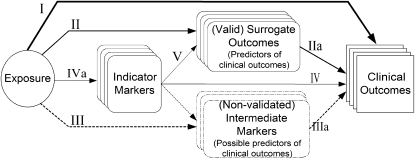FIGURE 1.
Generic analytic framework applicable to assessment of nutrients. The representation includes putative associations between an exposure (eg, a nutrient) and indicator markers of intake (eg, serum or tissue nutrient concentrations), nonvalidated intermediate outcomes, valid surrogate markers, and clinical outcomes. The solid arrows represent established associations among factors. Line thickness represents the relative directness of an association, and the strength of the relation with clinical outcomes. Dotted arrows represent associations to surrogate markers for which there is no direct evidence of an association with clinical outcomes. I. Association of exposure with clinical outcomes of interest. II. Association of exposure with surrogate outcomes for which there is “good” evidence of a linkage with clinical outcomes. IIa. Association between surrogate outcomes and clinical outcomes (“good” evidence for linkage) III. Association of exposure with surrogate markers for which the linkage with clinical outcome is uncertain. IIIa. Association between surrogate markers and clinical outcomes (uncertain linkage). IV. Association of indicator markers to clinical outcomes. IVa. Association between exposure and indicator markers. V. Association of indicator markers to surrogate outcomes (with good or possible evidence for linkage with clinical outcomes). Indicator markers (of nutrient intakes) are measures correlated with dietary intakes of a nutrient, such as biomarkers of intake, nutritional status, or markers of nutritional status. Biomarkers of intake are measurements of the nutrient itself or a metabolite of the substance in biological samples (eg, serum selenium) that have been validated to confirm that they reflect the intake of that nutrient. Nutritional status is the state of a person's health in terms of the nutrients in his or her diet and is a global term that encompasses a number of specific components from nutritional assessments. Nutritional assessment is a comprehensive approach to define nutritional status on the basis of physical examination, anthropometric measurements, and laboratory data, and medical, nutrition, and medication histories. Marker of nutritional status is a laboratory measurement or a physical sign that is thought to reflect the early stage of an abnormality (either deficiency or toxicity) of a nutrient intake. Changes induced by a nutritional intervention on the marker of nutritional status are expected to reflect the correction of the abnormality. Surrogate outcome marker is a laboratory measurement or a physical sign used as a substitute for a clinical outcome. Changes induced by a therapy on a surrogate outcome marker are expected to reflect changes in a clinical outcome. Clinical outcome is a measure of how a patient (or study subject) feels, functions, or survives or a clinical measurement of the incidence or severity of a disease (eg, diagnosis of disease).

